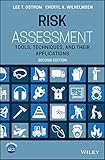Risk assessment : tools, techniques, and their applications / Lee T. Ostrom, Cheryl A. Wilhelmsen.
Material type: TextPublisher: Hoboken, NJ, USA : John Wiley & Sons, Inc., 2019Copyright date: ©2019Edition: Second editionDescription: 1 online resourceContent type:
TextPublisher: Hoboken, NJ, USA : John Wiley & Sons, Inc., 2019Copyright date: ©2019Edition: Second editionDescription: 1 online resourceContent type: - text
- computer
- online resource
- 9781119483373
- 1119483379
- 9781119483342
- 1119483344
- 363.1/02 23
- TA169.55.R57 O88 2019
| Item type | Current library | Shelving location | Call number | Status | Date due | Barcode | Item holds | |
|---|---|---|---|---|---|---|---|---|
 Electronic Book
Electronic Book
|
Kuakarun Nursing Library | Processing unit | Online Access | Eb34996 | ||||
 Electronic Book
Electronic Book
|
Kuakarun Nursing Library | Processing unit | Online Access | Eb34770 |
Includes bibliographical references and index.
Introduction to risk assessment -- Risk perception -- Risks and consequences -- Ecological risk assessment -- Task analysis techniques -- Preliminary hazard analysis -- Primer on probability and statistics -- Mathematical tools for updating probabilities -- Developing probabilities -- Quantifying the unquantifiable -- Failure mode and effects analysis -- Human reliability analyses -- Critical incident technique -- Basic fault tree analysis technique -- Critical function analysis -- Event tree and decision tree analysis -- Probabilistic risk assessment -- Probabilistic risk assessment software -- Qualitative and quantitative research methods used in risk assessment -- Risk of an epidemic -- Vulnerability analysis technique -- Developing risk model for aviation inspection and maintenance tasks -- Risk assessment and community planning -- Threat assessment -- Project risk management -- Enterprise risk management overview -- Process safety management and hazard and operability assessment -- Emerging risks -- Process plant risk assessment example -- Risk assessment framework for detecting, predicting, and mitigating aircraft material -- Inspection: a case study -- Traffic risks -- Acronyms.
"Since the first edition of our book was published there have been several changes in the types of risk individuals, businesses, and governments are being exposed to. Cyber-attacks are more frequent and costly and lone-wolf style terrorist attacks are more common; events not addressed in the first edition. The book continues to provide a resource that leads the reader through a risk assessment and shows them the proper tools to be used at the various steps in the process. This book also provides students studying safety and risk assessment a resource that assists them in understanding the various risk assessment tools. The book provides readers with a toolbox of techniques that can be used to aid them in analyzing conceptual designs, completed designs, procedures and operational risk. On top of the ten new chapters the new edition also includes expanded case studies and real life examples; coverage on risk assessment software like SAPPHIRE and RAVEN; and end-of-chapter questions for students with a solutions manual for academic adopters. The approach to the book remains the same and is analogous to a toolkit. The user locates the tool that best fits the risk assessment task they are performing. The chapters of the book progress from the concept of risk, through the simple risk assessment techniques, and into the more complex techniques. In addition to discussing the techniques, this book presents them in a form that the readers can readily adapt to their particular situation. Each chapter, where applicable, presents the technique discussed in that chapter and demonstrates how it is used"-- Provided by publisher.
Description based on online resource; title from digital title page (viewed on August 19, 2019).
Master record variable field(s) change: 050, 650
There are no comments on this title.

